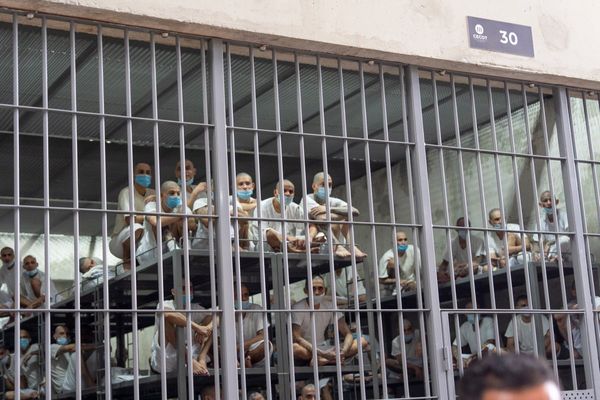
The UK government has declared it will put the first of 12 Aukus-class submarines in the water on schedule in the late 2030s, despite its own major projects agency saying the plan to build the nuclear reactor cores needed to power the submarines is “unachievable”.
The prime minister, Keir Starmer, has released Britain’s Strategic Defence Review, which argues the Aukus submarines are critical for the UK’s defence, and declaring a landmark shift in Britain’s deterrence and defence “moving to war fighting readiness to deter threats”.
The UK’s capacity to design and build the first Aukus submarine on time and on budget is critical for Australia. The first Australian-built Aukus nuclear submarine – based on the UK design – will subsequently be built in Adelaide and is expected to be delivered in the early 2040s.
Any delay or cost overrun in the UK program could leave Australia with a capability gap of no submarines, with the ageing Collins-class submarines already extended potentially decades beyond their scheduled service life, and doubts over the supply of US-built Virginia-class boats.
The Strategic Defence Review says the first of up to 12 British Aukus conventionally armed, nuclear-powered submarines will be in the water and operational “in the late 2030s” – the “optimal pathway” timeline previously announced as part of the Aukus agreement.
“With new state-of-the-art submarines patrolling international waters and our own nuclear warhead programme on British shores, we are making Britain secure at home and strong abroad,” the UK defence secretary, John Healey, said.
But the UK government’s own major projects agency has described the UK’s plan to build the nuclear reactor cores needed to power the Aukus submarines as “unachievable”.
In its latest annual report, released in January this year, the Infrastructure and Major Projects Authority (now the National Infrastructure and Service Transformation Authority), gave the nuclear reactor core project its lowest evaluation.
“Successful delivery of the project appears to be unachievable,” the report said.
“There are major issues with project definition, schedule, budget, quality and/or benefits delivery, which at this stage do not appear to be manageable or resolvable. The project may need re-scoping and/or its overall viability reassessed.”
Under “Pillar One” of the ambitious – and controversial – Aukus agreement, the US will sell between three and five of its Virginia-Class nuclear-powered submarines to Australia, the first of these in 2032.
However, legally, the US can only sell the boats if the then commander-in-chief – the US president – certifies that America relinquishing a submarine will not diminish its own undersea capability.
The US navy already has a shortfall of submarines, expected to worsen over coming years, and shipyards in America are running up to three years late in building new Virginia-class submarines, a US navy report found.
A recent US Congressional Budget Office report found America’s submarine industry is building 1.2 Virginia-class boat a year – well below the 2.3 needed for the US to meet its own needs and fulfil its commitment to Australia.
Aukus is forecast to cost Australia up to $368bn to the mid-2050s.
Australia is providing significant subsidies to the industrial bases of both the US and UK. It has already paid $A798m – the first instalment of $A4.7bn pledged – to the US. It will pay A$4.6bn to the UK.
The former South Australian senator Rex Patrick, an ex-submariner and Aukus skeptic, described the UK’s shipbuilding program as a “cluster-fiasco industry” trying to put “unachievable reactors into unachievable submarines”.
“We get announcements from places like Westminster, or Canberra, or Congress, saying ‘this is what we’re doing’. But unfortunately, the politicians who are making those calls simply don’t understand the complexity and difficulties of achieving what it is that they’re setting out.”
The US and UK, Patrick said, were “embracing Aukus at a political level, but unable to achieve it at a working level”. Patrick said it was highly unlikely the US could sell Virginia-class submarines to Australia early next decade.
And the implications for Australia were acute, Patrick said.
“We should have a plan B, but the current plan B is we will have no submarines. That is very disturbing, from the point-of-view of the taxpayer … forking out billions of dollars for a program that is likely not going to deliver, and from a national security perspective, where there’s a massive hole in the defence of Australia.”
Patrick said Aukus was diverting resources from other defence capabilities.
“It might be that we end up with no submarines and no other capabilities. And none of the people who are responsible for this program will be in the parliament when the whole thing runs aground.”
Australia’s defence minister, Richard Marles, told reporters at the Shangri-La Dialogue – an inter-governmental security conference – in Singapore at the weekend that Aukus was “on track”.
“We are meeting all the timelines that are associated with it. We are very optimistic about how it is progressing in the here and now.”
Males said Australia was seeing more visits from US nuclear-powered submarines to Australian bases, and was working on increasing the production and sustainment rates of Virginia-class submarines in the US, through financial contributions and having Australians working in US docks.
“We walk forward with a sense of confidence about the way in which Aukus is proceeding,” he said.







